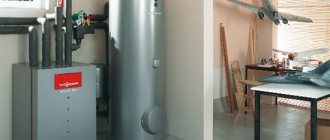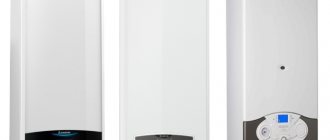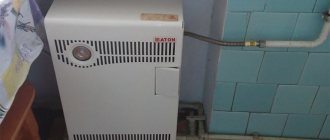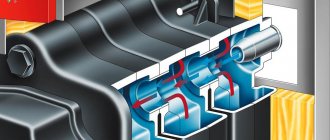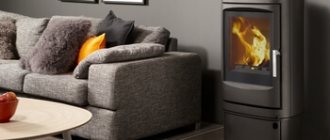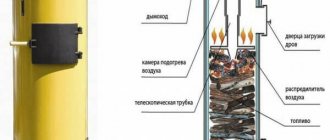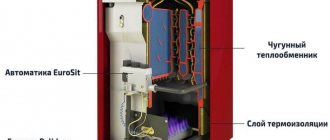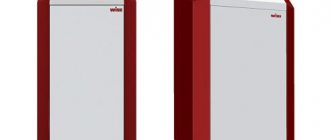If a gas main is connected to the house, you can choose a gas boiler without further hesitation: this is the most profitable, least labor-intensive and completely autonomous option for organizing heating. Floor-standing models are heavier, relatively simple and reliable; they can be equipped with a durable cast-iron heat exchanger with a service life of more than 30 years. They can work with almost any coolant.
In this material, we tried to describe in as much detail as possible all the criteria and nuances of choosing a floor-standing gas boiler, and gave examples of the most successful, efficient and best price-quality ratio household single-circuit and double-circuit floor-mounted gas boilers for 2020.
Rating of the TOP 12 best floor-standing gas boilers of 2021-2022
This rating includes the best floor-standing gas boilers for heating according to experts and ordinary users.
| Place | Name | Price |
| TOP 3 best floor-standing gas boilers in price-quality ratio | ||
| 1 | Lemax Premium-30B 30 kW | Find out the price |
| 2 | Lemax Premium-30N 30 kW | Find out the price |
| 3 | BAXI SLIM 1.150 i 14.9 kW | Find out the price |
| TOP 3 best floor-standing single-circuit gas boilers | ||
| 1 | Lemax Leader-25N 25 kW | Find out the price |
| 2 | Lemax Wise 25 25 kW | Find out the price |
| 3 | Lemax Premium-20 20 kW | Find out the price |
| TOP 3 best floor-standing double-circuit gas boilers | ||
| 1 | ATON Atmo 10ЕВМ 10 kW | Find out the price |
| 2 | Protherm Bear 30 KLZ 26 kW | Find out the price |
| 3 | Lemax Premium-20B 20 kW | Find out the price |
| TOP 3 best floor-standing energy-independent gas boilers | ||
| 1 | Lemax Patriot-10 10 kW | Find out the price |
| 2 | Lemax Premium-16 16 kW | Find out the price |
| 3 | Siberia 17 17.4 kW | Find out the price |
Basic criteria for choosing a boiler
In addition to the fuel consumption characteristics, there are a number of criteria that affect the economic parameters of the boiler. This applies to service life, device efficiency, materials, etc.
Material
The efficiency parameter of gas heating boilers is directly dependent on their service life. Gas units with a heat exchanger made of cast iron are considered to have the longest service life and reliability. These boilers are designed to last up to 50 years. But, the disadvantage of this material is its fragility, therefore, you need to be very careful when moving it. Only with careful and careful operation can a long service life be achieved. In addition to the required caution, it is also important to avoid temperature changes, for example, cold water should not come into contact with the surface of a heated heat exchanger, as this can lead to the formation of cracks.
Floor-standing units in which the contours are made of steel are not as capricious as those made of cast iron. But, at the same time, they are more susceptible to corrosion, therefore, their service life is shorter.
Availability of components
An important parameter affecting the service life is the commercial availability of spare parts, as well as their quality. When purchasing a unit, it is recommended to find out how easy it is to find the necessary components. Therefore, it is logical that it is easier to select the necessary parts for more well-known and popular brands.
Manufacturers
As for the country of origin, the most durable devices are considered to be those made in German, Italian and Slovakia. Similar equipment produced by domestic companies often has a shorter service life, although they are better suited to operating conditions in Russia and, in addition, they are lower in cost.
Scheduled checks
There are users of gas boilers who, to save money, do not contact service, or do not regularly carry out scheduled checks. However, this is a big mistake, since during operation of the boiler various situations can occur, for example, the burner focus shifts. This will lead to carbon deposits, and then minor malfunctions may occur. If they are not noticed and corrected in due time, this can lead to an increase in gas consumption and a decrease in boiler performance. This is a good example that you shouldn’t skimp on routine checks.
Unit efficiency
An important indicator that you need to focus on when selecting economical gas boilers for a private home is the efficiency factor.
For example, for floor-standing gas devices, efficiency = 85-90%. Lower performance is characteristic of cheaper units that are equipped with a single-stage or two-stage burner.
Boilers with smoothly varying power are considered more efficient. The heat generated during fuel combustion begins to heat the heat exchanger with the coolant. The residual heat then enters the atmosphere through the chimney.
The amount of heat that is lost can be calculated by measuring the flue gas temperature. A device in which the smoke is heated to 100-150°C is considered economical. If the temperature is more than 200°C, then the device does not have high economic performance.
A gas unit for housing with the highest economic parameters is considered a condensing boiler, which has a special technology for extracting heat from the formed condensate. Condensing boilers have an efficiency of more than 100%.
Taking into account various criteria that directly influence the economic performance of gas units, we can identify a number of models that have the necessary economic quality.
How to choose a floor-standing gas boiler?
Focus on the following parameters:
- Power . An average power reserve will allow the boiler to last not 1 or 2 years, but significantly longer. Add 25% to the optimal power indicator, and the result will be the very figure from which you should build.
- Material of manufacture . Gas boilers made of cast iron last the longest. But get ready to shell out a hefty sum for such a boiler.
- Device type . A condensing boiler is cheaper and more economical.
- Management . Choose a model with manual temperature control: sooner or later you will want to choose the appropriate indicators yourself.
- Safety . The boiler must have protection systems: gas control (which turns off the unit if there is a gas leak), protection against hypothermia and overheating.
Popular manufacturers of gas boilers: Neva, Lemax, ZhMZ, Navien, Protherm, Baxi, Viessmann, Buderus, Vaillant.
The best gas boilers for heating areas up to 200-300 sq. m.
As the heated space increases, the problem of saving gas fuel becomes more acute. To ensure low heating costs, when choosing a boiler you need to pay attention not only to power, but also to its efficiency. For some models from this rating (they work on the condensation principle) it exceeds 100%. Such data were obtained in accordance with domestic calculation standards, and according to the European methodology, their real efficiency is approximately 95%. Accordingly, in order to get an idea of the real efficiency of simple floor-standing gas boilers, the calculated efficiency value should be reduced by 12-15%.
Review of the best models in terms of price-quality ratio
Lemax Premium-30B 30 kW
The Premium series boiler is a Russian unit, powerful and reliable. In the first year of its release to the market, it received a lot
flattering reviews from customers.
The controls are electronic and intuitive, capable of heating a large living area. The unit itself is dual-circuit, compact, and takes up little space. The build quality is excellent. Heat exchanger material is steel coated with anti-corrosion enamel, fuel is natural gas (flow rate - 3.5 cubic meters per hour).
There is protection (gas control), a thermometer and overheating protection. Warranty period - 3 years. This model has proven itself well in 2021-2022.
Specifications:
- Maximum thermal power: 30 kW;
- Heated area: 300 sq.m;
- Efficiency: 90%;
- Weight: 88 kg;
- Dimensions: 556x961x470 mm.
pros
- easy to buy spare parts for repairs;
- powerful;
- economical;
- no problem with cheap fuel.
Minuses
- makes noise during operation.
Lemax Premium-30N 30 kW
Single-circuit boiler with good power, packed in a steel box (steel thickness - 2 mm).
No electrical connection required. Burner - micro-flare injection POLIDORO, Italian automatics. Anti-corrosion enamel can withstand temperatures up to 950°C and does not deteriorate even under aggressive environmental influences.
The temperature regulator is fixed on the front panel of the boiler. The top panel can be easily removed. There is a gas control function. Warranty - 3 years.
Specifications:
- Maximum thermal power: 30 kW;
- The approximate area of the heated room is 300 sq.m;
- Efficiency: 90%;
- Weight: 77 kg;
- Dimensions: 556x961x470 mm.
pros
- low gas consumption;
- there is enough power to spare;
- you can choose a comfortable thermal mode yourself;
- affordable;
- pleasant appearance;
- easy setup.
Minuses
- There is no protection against overheating and freezing.
BAXI SLIM 1.150 i 14.9 kW
Single-circuit floor-standing unit with average efficiency and good protective functions: gas control, air vent
, safety valve. There is frost protection, flame modulation, automatic ignition and underfloor heating.
There is a display on the front panel. The heat exchanger is made of cast iron. The combustion chamber is open. An indirect heating boiler with additional piping can be connected to the boiler.
The warranty period is 24 months. The fuel can be either natural or liquefied gas.
Specifications:
- Dimensions: 350x850x520 mm;
- Thermal power: 8.50 - 14.90 kW;
- Weight: 93 kg.
pros
- electronic control;
- reliable;
- economical;
- pressure gauge;
- pump blocking protection.
Minuses
- high price.
Selection of gas equipment
When choosing, the main task is much broader than simply determining which gas boiler is the most economical and reliable. It is necessary that the equipment meets the conditions of a private home and is suitable for the heating system. Solving this problem requires understanding what types of heat generators there are today and how they differ from each other. There are currently three types of gas-using equipment on the market:
- pressurized condensing boilers;
- supercharged (turbocharged) with a closed firebox;
- atmospheric with open firebox.
The above types are manufactured in wall and floor versions. Only in atmospheric boiler models can you choose wall-mounted (parapet) products with a side chimney outlet that goes horizontally to the street through the wall. There are double-circuit varieties of boilers that are used as a boiler to provide hot water.
The design in a wall-mounted or floor-mounted version does not affect the power and practicality of the boiler. The only thing that matters is the operating principle and design of the heat generator.
Atmospheric units
This gas equipment is not one of the most economical devices, since the efficiency does not often exceed 83%, and the temperature of the burned gas at the exit into the pipe is about 160 °C. The reason is the usual version of fuel combustion with a free supply of oxygen from the boiler room. When there is an excessive amount of air in the air-fuel mixture, not the most favorable conditions for fuel combustion begin to be created, which negatively affects the efficiency of the heater. An increased temperature of combustion products indicates ineffective heat exchange and loss of thermal energy.
There is one more important point. Many burners that are installed in cheap atmospheric boilers can only operate in one mode. In other words, to maintain the temperature of the coolant, the burner is regularly turned on and off. This is the simplest operating principle, but not the most economical. But one way or another, this equipment is very popular for several reasons:
- reliability and simplicity of the device;
- lack of electrical components;
- independence from the availability of electricity;
- low cost.
Not all atmospheric equipment is energy independent. There are a large number of models from different manufacturers that are equipped with automation and control equipment that consume electricity. However, their presence does not increase the efficiency of boiler equipment.
To heat a house with an open firebox that works naturally, it is best to install an atmospheric boiler that does not require electricity. Even despite the relatively low power of this equipment. These units are designed to heat buildings in areas with unstable electricity supply. In this case, we are not talking about savings if during a power outage the boiler stops working and the rooms in the house begin to cool.
Pressurized thermal generators
The closed combustion chamber and forced air circulation, which are implemented in these devices, improve the combustion conditions of liquefied and natural gas. In turbocharged boilers, unlike atmospheric ones, the following types of burners are used:
- modulation;
- two- and multi-stage.
The idea is that when the specified coolant temperature is reached, these burners switch to a lower level of fuel combustion activity (first type) or smoothly reduce the intensity of the combustion process to a minimum (second type). That is, the automated boiler control system itself controls the burner power, taking into account the thermal load or the signal from the DHW operation. It is for this reason that the efficiency of turbocharged boilers is 91-95%.
According to reviews, turbocharged wall-mounted gas boilers are in first place for individual heating of apartments. However, not at all because of the increased efficiency, but due to the coaxial chimney, which is horizontally discharged to the street through the wall. This allows you not to equip a chimney pipe, and also not to connect the heating device to the ventilation shaft, which is strictly prohibited by SNiP.
Condensing devices
By and large, these are the same forced-air heat generators with a closed firebox, but with increased efficiency - up to 97%. This is achieved thanks to the closed design of the heat exchanger, which surrounds the cylindrical burner around the entire perimeter. Thus, it is possible to recover the thermal energy of vaporization lost during combustion. The resulting water begins to evaporate at elevated temperatures during combustion, then the steam, after contact with the heat exchanger, condenses and transfers back thermal energy.
Condensing gas equipment is the most economical equipment for heating a private home. Provided that electricity is supplied to the area without interruption or there is an alternative power source - a diesel or gasoline generator . Like turbocharged heating boilers, condensing equipment cannot operate without electricity.
Since these devices are more technologically advanced, their cost is quite high. This can be attributed to the only significant drawback; according to other characteristics, only electrical installations with an efficiency of 98% are more economical.
Review of the best single-circuit models
Lemax Leader-25N 25 kW
The stylish boiler is made in red and white colors and does not require a network connection. Has all the necessary programs
protection, reliable and high quality.
The cast iron heat exchanger perfectly maintains the temperature and, thanks to its high heat transfer, warms up the home well. The starting system operates smoothly and the controls are simple.
The temperature regulator is installed on the front panel. The micro-torch burner ignites without problems. Fuel is natural gas.
Specifications:
- Max. thermal power: 25 kW;
- Heated area: 240 m²;
- Dimensions: 515x856x515 mm;
- Efficiency: 90%;
- Max. thermal load: 30 kW.
pros
- automatic Nova;
- gas control;
- overheat protection;
- pressure gauge
Minuses
- very heavy (115 kg).
Lemax Wise 25 25 kW
Ergonomic boiler with low gas consumption (for this level of units) and a set of protective programs, reliable
and relatively inexpensive. There is a convenient display and power indicator.
The installed automation system, made in Italy, is resistant to voltage surges, does not make noise, and allows you to connect additional devices (for example, a turbo nozzle, circulation pump, etc.).
The warranty period is 24 months.
Specifications:
- Max. thermal power 25 kW;
- Efficiency: 90%;
- Weight: 116 kg;
- Dimensions: 515x860x520 mm.
pros
- gas control protection;
- it is possible to connect external control;
- auto diagnostics;
- flame modulation;
- frost protection;
- power-on indication.
Minuses
- heavy weight.
Lemax Premium-20 20 kW
Inexpensive and quite simple, but with a standard set of functions, a boiler for a house with an area of 200 sq.m.
The heat exchanger is made of high-strength steel. Powerful, with good heat dissipation. Gas consumption is economical, the removable panel allows you to clean it yourself.
The model is equipped with automatic ignition. Safe: functionality includes gas control, protection against draft blowing and protection against heat exchanger overheating. It does not take up much space, as it is small in size. Chimney diameter is 130 mm.
Specifications:
- Boiler warranty: no more than 3 years;
- WxHxD: 556x961x470 mm;
- Gas consumption: 2.4 cubic meters m/hour;
- Thermal power (maximum): 20 kW.
pros
- intuitive control panel;
- the boiler is easy to operate;
- affordable price;
- high efficiency.
Minuses
- makes noise.
Installation benefits
Today, gas heating equipment is widely used in country cottages and private homes. Ease of operation, safety and convenience are the main reasons for the popularity of gas heating. The boilers also have a number of other advantages:
- maximum thermal efficiency;
- increased productivity, which is ensured by the efficient use of fuel through the use of modern technological developments during the creation of combustion chamber designs;
- the ability to heat a building even of a very large area;
- economical fuel consumption due to an automatic control system;
- additional possibility of connecting devices and sensors that are capable of controlling temperature conditions, thereby creating a comfortable microclimate in the house;
- Huge functionality: modern operation control devices that ensure safe operation of the equipment, various operating modes, in particular, “sleep” mode and automatic switching on when the gas supply is restored, different temperature control ranges, this allows the use of boilers for “warm floor” systems ;
- ease of maintenance and ease of repair due to the installed diagnostic system, which allows you to automatically identify dozens of types of probable faults;
- trouble-free and long-term operation;
- small dimensions of heating devices;
- minimum noise level;
- long operating time even without regular maintenance;
- environmental friendliness and low release of toxic substances into the external environment;
- increased security;
- affordable price.
The heat exchanger of floor heating equipment is made of high-quality and durable cast iron, which provides the best thermal insulation, and modern burners make it possible to operate the device simultaneously on both liquefied and natural gas.
In addition, floor-standing boilers clearly respond to the negative influences of the external environment; their body is coated with special anti-corrosion compounds that prevent metal oxidation.
Review of the best dual-circuit models
ATON Atmo 10ЕВМ 10 kW
Trouble-free unit with mechanical control. High quality assembled. The combustion chamber is open, efficiency is 90%. Material
heat exchanger - high quality steel. Only natural gas is suitable as fuel. Automation - EUROSIT.
The coolant temperature range is 50-90 °C. The model operates completely silently, is easy to set on fire and rarely breaks. Chimney diameter - 110 mm. Capable of heating an area of about 100 sq.m.
Specifications:
- Thermal power: 10 kW;
- Weight: 44 kg;
- Dimensions: 380x760x385 mm.
pros
- thermometer;
- gas control;
- inexpensive;
- long warranty period.
Minuses
- small heated area.
Protherm Bear 30 KLZ 26 kW
Massive double-circuit boiler with a full set of amenities: pressure gauge, thermometer, auto-ignition, gas control
, flame modulation, autodiagnostics. Included: built-in circulation pump and expansion tank.
In case the pump is blocked, special protection is installed. Indicators in the DHW circuit are 40-70 °C. Natural gas consumes 3 cubic meters. m/hour, liquefied - 2.4 kg/hour. A single-phase network extension is required.
Specifications:
- Thermal power: 18.20 - 26 kW;
- Parameters: 505x1385x730 mm;
- Weight: 155 kg.
pros
- warranty period: 730 days;
- electronic control;
- built-in boiler;
- overheat protection.
Minuses
- very heavy.
Lemax Premium-20B 20 kW
Budget model made of steel, impact-resistant and durable. The gas supply stops automatically if
failure, as well as the burner is switched off when abnormally high water temperatures are detected.
Long warranty period (3 years). There is overheating protection, a thermometer on the body and gas control. The volume of gas consumed is 2.4 cubic meters. m/hour. The coolant can withstand a maximum of 90 degrees. Capable of heating 200 sq.m. premises.
Specifications:
- Dimensions: 556x961x470 mm;
- Weight: 83 kg;
- Claimed power 20 kW;
- Unit parameters: 556x961x470 mm.
pros
- inexpensive;
- large heated area;
- durable body;
- good build.
Minuses
- susceptible to corrosion;
- the main parameters can only be adjusted manually.
Reasons for the attenuation of atmospheric gas boilers with an open combustion chamber
Atmospheric gas boilers usually go out due to external factors, but malfunctions in the internal components can also be the cause:
- blockage of the holes of the gas burner device;
- failure of communication of the emergency electrical circuit;
- lack of draft or wind blowing into the chimney;
- poor supply ventilation or clogged duct;
- insufficient fuel supply pressure in the lines.
According to the safety rules in the gas industry PB No. 12-368-00, if the boiler goes out suddenly (if this is not an automatic operation), then it is strictly prohibited to start re-igniting without finding out the reason for what happened! Failure to comply with this requirement may result in a fire, explosion or carbon dioxide poisoning of people. Therefore, we strongly recommend that if any emergency situation arises, you contact boiler specialists. For our part, we recommend gas boiler service from VDOMEVODA.
Clogged nozzle or burner filter
If, when the control knob is switched to the “START” position, the igniter (wick) does not ignite, this is a sure sign that the starting elements of the unit are clogged: nozzles (nozzles) of the ignition nozzle, a fine-mesh filter at the inlet or a pilot burner filter. They can be easily cleaned using available products.
The location of the pilot nozzle on the burner block of a floor-standing gas boiler.
The filters are simply blown through in any convenient way (air sprayer, handheld vacuum cleaner or mouth) until air flows freely through them. But the injectors will have to be more thoroughly scraped off from carbon deposits (with thin copper wire) - until the design diameter of the nozzles returns. Under no circumstances should the nozzle be damaged or the diameter of its orifice specified by the manufacturer be changed.
How to clean an entire gas boiler and extend its service life: detailed instructions
Thermocouple, circuit contacts, or solenoid malfunctions
If communication with the thermocouple is disrupted, incorrect signals are sent to the solenoid valve that there is no flame, and accordingly the gas supply is stopped.
It doesn’t matter whether the gas boiler goes out immediately when you release the start button, or after turning on another mode - this behavior indicates problems in the circuit:
- contacts of the thermostat, thermocouple or vacuum sensor are broken;
- the thermocouple does not provide the required voltage or does not enter the flame zone;
- unsuitability of the thermostat, electromagnet coil or thermocouple.
The location of the thermocouple on the burner block of a floor-standing gas boiler.
All these reasons for the extinguishing of a gas boiler can also be corrected with your own hands, the main thing is to follow the sequence of steps “from easy to complex”:
- check the resistance of the sensors and connecting wires one by one with a tester (multimeter) - normally the indicator should not exceed 0.3–0.5 Ohm;
- if traces of oxidation are detected, clean all joints with fine emery cloth (zero) from rust and short-circuit the loose contacts;
- carefully disconnect the thermocouple from the main unit, connect the tester (millivoltmeter) and, while holding the start button, turn on the pilot burner;
- measure the voltage - normally the indicator should not exceed 10–50 mV, if everything is in order, then return the thermocouple back and adjust its position;
- if there is no voltage, remove the top cover of the main unit, heat the thermocouple with a torch, press the safety valve and release;
- if the valve still does not hold, then pull out the block with contacts and apply voltage (220 V power supply) directly to the coil, bypassing the thermostat.
Now you can start the boiler: if the problem remains, the old thermocouple and solenoid valve coil are simply replaced - they cannot be repaired.
Lack of draft or reverse draft when wind blows into the pipe
Another common reason for flame extinction in a gas boiler is lack of draft. To check whether there is an air flow through the firebox, you should bring a lit match to the viewing window and observe how the fire behaves: if the tongue reaches towards the opening, then there is a draft, but if it stands level, then there is no draft. Be sure to close the gas supply valve securely.
Next you need to remove the part of the pipe connected to the outlet pipe and also check the draft in the chimney - further actions depend on the result:
- if there is draft, you will have to clean the boiler channels;
- If there is no draft, just clean the chimney.
There may be soot, bird nests, fallen leaves or other debris inside the system. The blockage is localized both at the inlet and in the upper part of the pipe: in the first case, it is easy to deal with yourself, but in the second, it is advisable to entrust the matter to a specialist, since you will need special tools and the ability to work from the roof.
Sometimes the boiler goes out due to the appearance of reverse draft - when the wind blows into the chimney, the smoke does not come out, but returns back to the firebox, which knocks out the flame.
In strong winds, this can happen to everyone a couple of times a year - it’s not scary, but if reverse draft occurs regularly, you already need to take measures:
- install a protective cap (mushroom umbrella, cap, deflector) at the edge of the chimney, which will protect the entrance to the pipe from unwanted weather influences;
- lengthen (increase) the pipe by 1–2 m if, due to the height of the nearest houses, it enters the “wind shadow” zone, i.e., disruption of the circulation of air masses.
According to the building codes SNiP II-35 and SNiP 02.04.05, it is prohibited to install cornice-type caps on the chimney of a gas boiler! But in some situations this may be the only way out, so even if the deflector is not included in the project, it is worth discussing the possibility of installing it with the gas workers.
Details about what to do if the gas boiler is blown out by the wind
Lack of oxygen for gas combustion
Lack of normal ventilation (through the built-in duct or neighboring rooms) also often leads to boiler failure. There may be several reasons:
- sealed plastic windows and balcony doors;
- interior doors without clearance, their insulation;
- improper layout (insulation) of the boiler room;
- too powerful kitchen hood over the stove;
- forced ventilation in the bathroom rooms.
It’s easy to verify that there is an oxygen deficiency; just open the nearest window and look at the burner: if its flame has stabilized, then everything is clear.
The shortage can be filled by installing supply valves on windows or organizing a system for forced intake of fresh air from the street.
Reduced pressure in the gas line
The main sign of low fuel supply pressure is the burner constantly turning off, although the pilot flame does not go out at this moment.
First, it’s worth assessing how gas flows from the pipeline: unscrew the hose of the pipes and open the valve completely - this will help determine the cause:
- if there is a strong hiss and the smell of methane, everything is in order with the supply;
- if the signs are indistinguishable, the problem is in the gas supply system itself.
After obtaining the result, you need to close the shut-off valve, return the hose to its place and check the tightness of the joints using a soap solution.
If a leak is detected, you must immediately turn off the gas taps, open all windows and doors, remove people from the premises and call the emergency service (04, 104 or 112). Before her arrival, you must not turn on the lights, use electrical appliances, or sources of open fire or sparks.
If there is no gas leak, you need to deal with the meter: sometimes scale or rust remains in it after repairs, which is why gas does not flow well. You can identify the malfunction yourself - a clogged device gives incorrect readings, but according to Law No. 261-FZ, only professionals have the right to clean it.
The problem may also be caused by a change in season: in winter, gas consumption increases, so if the supply volume remains the same, the pressure decreases.
How to choose a room thermostat and save up to 30% per month on heating
Review of the best non-volatile models
Lemax Patriot-10 10 kW
Russian boiler with a closed combustion chamber and an improved protection system. The functionality is simple, but it gets the job done
. For individual heating of a small area, its power is quite enough.
Small steel heat exchanger. It consumes little gas and heats up well. The assembly is good. Mechanical control. The maximum coolant temperature is 80 °C. Weighs 50 kg. Chimney diameter is 250 mm.
Specifications:
- Service life: 3 years;
- Max. thermal power: 10 kW;
- Fuel: natural gas only;
- Dimensions: 595x740x360 mm.
pros
- durable;
- qualitative;
- affordable.
Minuses
- It cannot be used as a gas water heater, only for heating.
Lemax Premium-16 16 kW
Another inexpensive but high-quality model for those who only care about warmth and not “bells and whistles.” Neatly assembled box
covered with an inhibitory anti-corrosion composition and heat-resistant enamel.
Practical and reliable energy-independent model for an area of up to 120 sq.m. Can be installed both in residential and non-residential premises. The temperature sensor is located on the top panel for user convenience. Weight - about 60 kg. Thermal power - 16 kW.
Specifications:
- Allowable heating area: 160 sq.m;
- WxHxD: 416x744x491 mm;
- Warranty period: 3 years.
pros
- easy controls;
- economical model;
- quickly warms up the home;
- convenient to clean.
Minuses
- a bit expensive for boilers of this level;
- volatile
Siberia 17 17.4 kW
A relatively cheap, domestically assembled miniature heating unit with Italian “stuffing”.
The media temperature sensor is located on the control panel. Weighs more than 50 kilograms, the heat exchanger has thick steel walls. Piezo ignition with flame control.
It is not capricious in maintenance, breakdowns (according to customer reviews) occur very rarely. High quality build. The combustion chamber is open. Compact, takes up little space.
Specifications:
- Thermal power: 17.40 kW;
- Area: 200 sq.m;
- Highest carrier temperature: 90 °C.
pros
- attractive design;
- compact;
- automation and burner made in Italy;
- inexpensive;
- high efficiency.
Minuses
- makes noise when ignited.
Closed floor standing boiler
Boilers with automated combustion process.
- The combustion chamber in them is closed and air exhaust systems are provided.
- Automation is computerized.
- It is possible to program the heating temperature and operating time.
- Modern models use remote control units.
- For the smooth operation of such a unit, electricity is required.
Floor-standing or wall-mounted gas boiler - which is better?
Let's look at the main differences between floor-standing and wall-mounted boilers:
- The efficiency of wall-mounted boilers is 90-94%, lower floor-standing boilers are 88-90%. This means that the lower the efficiency, the higher the energy consumption. Most floor-standing boilers are convection boilers. Their price is lower, they are also inexpensive to repair, but they are also less efficient. Boilers that are attached to the wall can be either convection or condensation. In condensation systems, the heat generated from combustion products and gases passes into the coolant, and not into the atmosphere, i.e. it is used efficiently (this requires the construction of a condensate drain, but this work is simple).
- The service life is affected by the material of the heat exchanger, and not by the number of structural elements and their connection in certain variations. Heavy cast iron is often used - a thick and very durable material that is not afraid of corrosion and is very durable. Such a boiler can operate for at least 20 years, or even 25. Copper or steel are used in suspended structures. Steel is cheaper than copper, but is thin, and will last 12-13 years. Whether it’s copper: units with copper elements last 5-8 years longer and conduct heat better, but they also cost significantly more.
- Fun fact: manufacturers generally prefer to create entire boiler rooms in miniature from wall-mounted boilers, and use floor-standing boilers to a minimum. Regarding dimensions: do not think that the larger and more massive the boiler, the better it works. Most often it happens just the opposite.
- Each region has its own nuances of power supply: a non-volatile boiler will continue to operate even in your area “the lights will be turned off.” Half of all floor-standing boilers on the market are non-volatile, and there are plenty to choose from. But wall-mounted ones require connection to the electrical network, without exception.
- Automation in wall-mounted boilers is better, so these types of models are safer and more convenient to use. They also have overheating protection, self-diagnostics, freeze protection and a lot of other useful functions. Floor-standing ones boast automatic ignition (rarely), overheating protection and gas control.
- Wall-mounted structures cannot work with some coolants, for example, antifreeze on copper and steel heat exchangers has a simply destructive effect. But the same antifreeze is perfect for floor-standing boilers.
- One- or two-stage burners are installed in floor-standing boilers (they can operate either in on/off mode, or with adjustment at 50 or 100% power), in wall-mounted boilers - modeled ones (the indicators can be adjusted by the user himself as he pleases). The situation with chimneys is this: since almost all floor-standing boilers have atmospheric burners and open combustion chambers, the chimney for them must be removed separately . The wall-mounted units have a convenient coaxial chimney.
- Mounted boilers are cheaper and there is more choice than floor-standing boilers. And they are easier to maintain.
From the above, we can draw the following conclusion: the most reliable are floor-standing mini-boilers, since they are unpretentious even with a serious “minus” outside the window and they have a more durable heat exchanger.
Open type floor standing boiler
The combustion chamber of such a boiler is open. During operation, it uses the air of the room in which it is installed.
- This single-circuit floor-standing boiler does not require an electrical connection.
- The power is regulated mechanically, the burner is equipped with a piezo lighter.
- Capable of heating large areas. The disadvantage is the high requirements for the premises.
When installing a boiler with an open combustion chamber, a chimney is required, because natural traction is used.
Types of floor-standing gas boilers
There are several types:
- Single-circuit - in their connection diagram the boiler and the boiler do not depend on each other, i.e. this unit will act exclusively as a heating device. To warm water for, for example, washing, you will have to buy a boiler separately and invite a specialist to connect it to the boiler. A single-circuit boiler is inexpensive.
- The double-circuit one has 2 heat exchangers inside, due to which it heats water for domestic needs. It costs more.
- A condensing boiler is a high-efficiency unit, which means little money is spent on maintenance. But the boiler itself is expensive. In such a device, heat is released during the process of steam condensation.
- Convection is an option with low efficiency. The energy released when the gas burns heats the water. This unit is inexpensive, easy to install and easy to work with.
The principle of boiler efficiency
Ideally, a heating boiler must first effectively burn liquefied or natural gas, and then redirect the resulting heat to heat the coolant. But in reality, everything does not always go so smoothly, and for these reasons:
- To effectively burn fuel and obtain maximum thermal energy, it is necessary to mix gas and oxygen in a precise ratio (approximately 1:10). Not every heating device can do this.
- During the fuel combustion reaction, carbon dioxide and water are formed, which immediately begins to evaporate, taking away part of the thermal energy.
- Heated combustion products by their nature cannot completely transfer energy to the heat carrier; a certain part of it still leaves through the chimney. This value will depend on the design of the boiler equipment.
Thus, one part of the energy contained in the fuel is lost during the combustion stage, and the second part is lost during thermal transfer. The lower these losses, the more productively energy is consumed and the more economical the gas boiler is. The operating efficiency of a heating device is expressed in its efficiency, which is indicated in the manufacturer's instructions. The higher this characteristic, the more thermal energy is directed to heating the coolant and the gas is burned more economically.
The efficiency of modern gas equipment depends on the design of the boiler and is in the range of 80−95%. The more inflated power ratings indicated by manufacturers of heating appliances do not correspond to reality.
How to choose the power of a gas boiler?
Calculating the boiler power is also not difficult. The ideal is taken to be a normally insulated room with ceilings no more than three meters high, with pressure in the gas pipeline of approximately 14-15 mbar, excluding water heating. In this case, 1 kW is required per 10 square meters.
You should also take into account the region of residence (especially average winter temperatures), how many doors and windows there are in your apartment (house) (the so-called thermal conductivity is of interest here). Remember that the lower the minimum power of the unit, the more economical it will work.
In some cases, a boiler is required whose power is 1.5-1.7 times greater than that required under ideal conditions. Therefore, if you are not sure that you can calculate everything correctly, contact a specialist: he will draw up an individual project, taking into account all the features of your home and the environment.
Choosing a floor-standing boiler: how not to make a mistake
Before you go to the store, you should carefully analyze the features of the heated object in order to clearly understand the operating conditions of the device. Based on this, the characteristics of the equipment are selected.
Gas unit power
One of the main factors determining the choice of boiler. Standard recommendations suggest determining the required power of the device from the following ratio: 10 sq.m of building will require 1 kW of power produced by the unit.
However, this is a very average figure. It does not take into account the heat loss of the building, the height of the ceilings in the room, the number of doors and windows, their thermal insulation and much more. If possible, a specialist should calculate the required boiler power.
One more thing. It is usually recommended to select a boiler with some power reserve. This is fair, but this reserve should not be large. Otherwise, this will lead to rapid wear of the equipment and constant excessive fuel consumption. For single-circuit boilers, the power reserve should not exceed 15%, for double-circuit boilers 25%.
Specifics of fuel consumption
If possible, it is advisable to choose the most economical boilers. These include all condensation models. Compared to traditional devices under similar conditions, they consume 15-30% less fuel. An electronic ignition system will also help you save money.
Standard piezo ignition requires constant operation of the pilot burner, which leads to excessive gas consumption. This is not necessary for an electronic system. Such boilers are more expensive, but during operation the investment quickly pays off.
Double-circuit boilers are very convenient for small buildings, as they allow you to simultaneously heat the house and provide it with hot water
Optimal number of circuits
It makes sense to think about purchasing a double-circuit boiler only if there is a need for hot water supply. In this case, it is worth installing a device with two circuits only in a building of small or medium size.
For large houses, installing double-circuit boilers is impractical, since the device’s power is often not enough for full operation. In addition, the security of the system suffers.
Priority heat exchanger material
Copper is not considered in this case. Only steel or cast iron. The first option is chosen if you want to save money. But you need to be prepared for the fact that in a few years you will have to change the heat exchanger. For long-term trouble-free operation of the boiler, a cast iron unit is chosen.
Design type and performance
For floor-standing gas boilers, efficiency is considered normal, varying in options from 80 to 98%. Condensing models differ in efficiency ranging from 104 to 116%. The higher this value, the more efficiently the boiler operates and uses less fuel.
For dual-circuit models, the performance of the DHW system can vary from 2.5 to 17 liters per minute. The performance and power of the unit affect its cost; the higher it is, the higher the price of the device.
Best control system
The most convenient and safe to use are boilers with automatic control. They are able to function autonomously, without constant control of the owner. These are expensive, complex systems.
It is also possible to use more budget-friendly manually controlled boilers, but in this case its operation will have to be controlled by turning the device on/off to obtain a comfortable temperature in the room.
An excellent option in the operation of a gas boiler is the presence of a built-in thermostatic sensor. If you don’t have one, it is recommended to purchase and install a thermostat so as not to waste energy and overload your heating equipment.
Floor-standing boilers with automatic control are considered the most convenient to use. They do not require constant monitoring, yet they work safely and efficiently
The rules for adjusting the automatic control unit of gas equipment are given in the article, the contents of which we advise you to familiarize yourself with.
Acceptable design and dimensions
The dimensions of the boiler and its appearance are selected based on the area of the combustion room. Manufacturers offer a large selection of a wide variety of models of various designs and dimensions, which allows you to choose the device that is most suitable for a particular room. It is important to remember that the boiler and additional equipment must be provided with completely free access.
The best models of gas boilers are presented in the article, which sets out in detail the selection criteria and provides all the arguments on the basis of which you can make an informed purchase.
